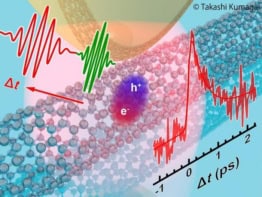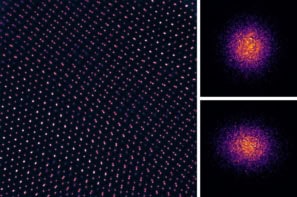
Researchers in the US have unveiled a new technique to repair nanometre-sized defects using oil-based microcapsules filled with a nanoparticle solution. The microcapsules roll or glide over a surface and stop to repair any cracks or imperfections that they encounter by releasing their nanoparticle cargo into them. They then move on to the next defect. The technique could have numerous practical applications in industry and research because it avoids the need to coat an entire surface when only a small fraction of it has been damaged. It might also be used as a precise way to detect damaged substrates by depositing sensor material into the regions of concern.
The technique was developed by two teams working in collaboration – one led by Todd Emrick at the University of Massachusetts and the other by Anna Balazs at the University of Pittsburgh. It was inspired by computer-modelling work done by Balazs. “Using computer simulations, she predicted that if nanoparticles were held in a certain type of microcapsule, they could probe a surface and release the nanoparticles into certain specific regions,” explains Emrick. “This concept applies particularly well to damaged surfaces, where the defective regions typically possess characteristics that are very different to the undamaged part of the sample – in terms of their topography, wetting properties, roughness and chemical functionality.”
Such a “repair-and-go” approach is inspired by naturally occurring biological mechanisms in the body. Leukocytes, for example, probe, identify and heal wounded or diseased tissue. It has also found use in medicine – cancer drugs are routinely encapsulated to ensure that they preferentially permeate into “leaky” cancer tissue rather than healthy surrounding tissue, says Emrick.
Rolling capsules
Using a polymer surfactant that stabilizes oil droplets in water, the researchers encapsulated cadmium–selenide nanoparticles in such a way that the particles can be released when desired. This was possible because the walls of the capsules are very thin – about the same size as the diameter of the nanoparticles themselves. The researchers then found that the capsules roll or glide over damaged substrates and selectively deposit their nanoparticle contents into the damaged or cracked regions thanks to hydrophobic–hydrophobic interactions between a nanoparticle and the cracked surface. Cadmium selenide is fluorescent, which means that the nanoparticles can easily be tracked using an optical microscope.
“Our research could have numerous practical applications,” says Emrick. “For one, it could help massively lower the amount of material required when repairing a damaged object or sample, thus avoiding the need to coat an entire surface when only a very small fraction of it is damaged.”
The technique could also be exploited as a precise method for detecting damaged substrates, by depositing sensor material into the regions of concern, he adds.
“Looking forward, this rapid and efficient coating mechanism might come in useful for repairing a wide range of objects – from aeroplane wings to microelectronic components and biological implants,” says Emrick. “Having realized the concept experimentally, we now plan to demonstrate how the mechanical properties of coated objects can be recovered by adjusting the composition of the nanoparticles being delivered.”
The work will be described in Nature Nanotechnology.



